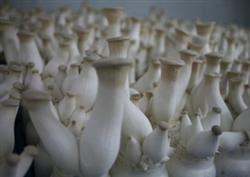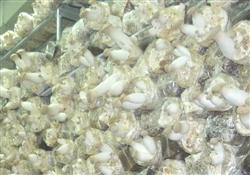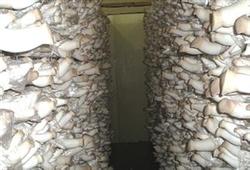Skillful improvement of inoculation method of Pleurotus eryngii

At present, most of the bag cultivation method is used to cultivate Pleurotus eryngii. The inoculation methods include one inoculation method and two inoculation methods. Using these two inoculation methods, especially manual bagging, often leads to inconsistent mycelium growth inside and outside. To overcome this disadvantage, it is necessary to improve the inoculation method of Pleurotus eryngii. The method of hole seeding inoculation can be adopted, that is, the strain is inserted into the culture medium 2~3 cm deep, the hole mouth is filled without leaving any gap, 4 holes are inoculated in each bag, and the bag is sealed with a breathable sticker. In this way, after the bacteria at both ends of the bag germinate, the two ends of the bag can be covered tightly, the whole bag is completely surrounded, and the hyphae grow inside and outside at the same time. Compared with conventional inoculation method, the method of hole seeding inoculation can fill up the mycelium bag 7 days earlier, and it is easy to operate and less polluted. Therefore, one or both of Pleurotus eryngii cultivation households can be changed to hole seeding inoculation. It should be noted that the bag mouth must be tightened when loading culture materials. No matter in the inoculation box or in the inoculation tent, the inoculation should be sterilized and sealed immediately after inserting the strain.
- Prev

What is the cause of Pleurotus eryngii bag pollution?
There are mainly the following reasons, which you can analyze according to the specific situation. 1. The disinfection of the bacterial bag is not complete, and there are miscellaneous bacteria in the culture material. two。 The inoculation workshop was not disinfected and there were miscellaneous bacteria in the air. 3. The strain is not pure and contains miscellaneous bacteria. 4. During the culture period, the ventilation was poor, and the relative humidity of the culture room was high. 5....
- Next

Control of common diseases and insect pests of Pleurotus eryngii
Pleurotus eryngii is also known as Pleurotus ostreatus because it mainly grows on plants such as parsley of Umbelliferae. Pleurotus eryngii is rich in nutrition, fruiting body contains about 16% protein, 11% crude fat, 6% ash, 4% crude fiber, rich in 18 kinds of amino acids, excellent taste. Regular consumption can prevent cardiovascular disease, diabetes and obesity, and has beauty.
Related
- Fuxing push coffee new agricultural production and marketing class: lack of small-scale processing plants
- Jujube rice field leisure farm deep ploughing Yilan for five years to create a space for organic food and play
- Nongyu Farm-A trial of organic papaya for brave women with advanced technology
- Four points for attention in the prevention and control of diseases and insect pests of edible fungi
- How to add nutrient solution to Edible Fungi
- Is there any good way to control edible fungus mites?
- Open Inoculation Technology of Edible Fungi
- Is there any clever way to use fertilizer for edible fungus in winter?
- What agents are used to kill the pathogens of edible fungi in the mushroom shed?
- Rapid drying of Edible Fungi

